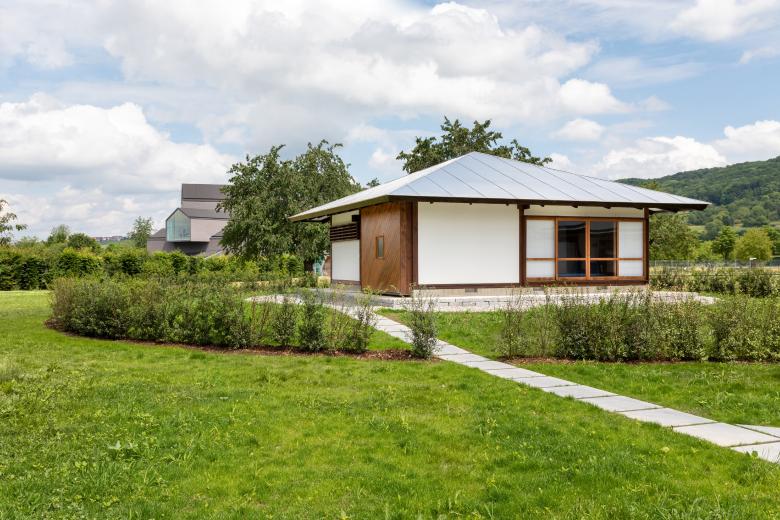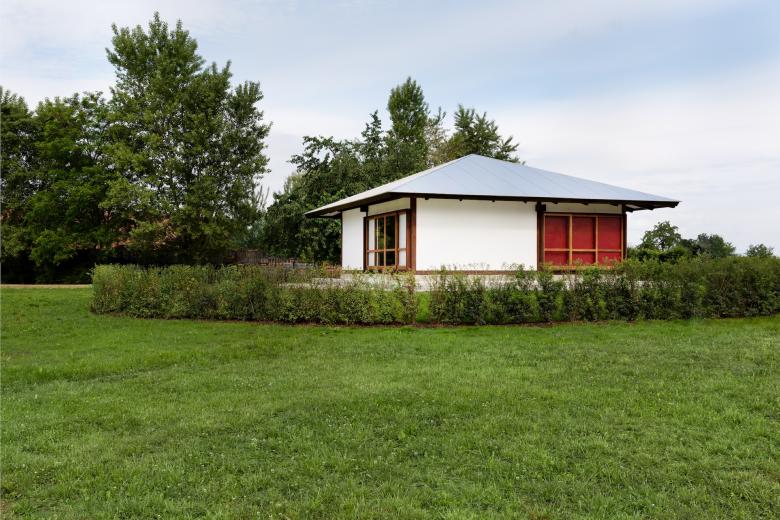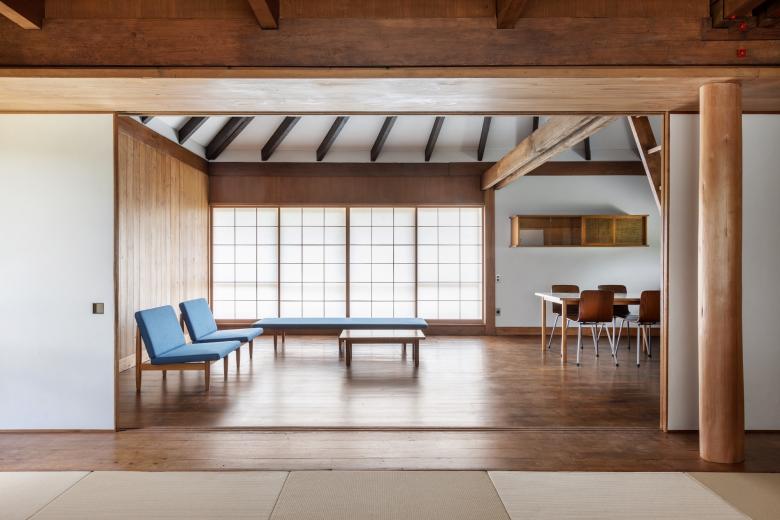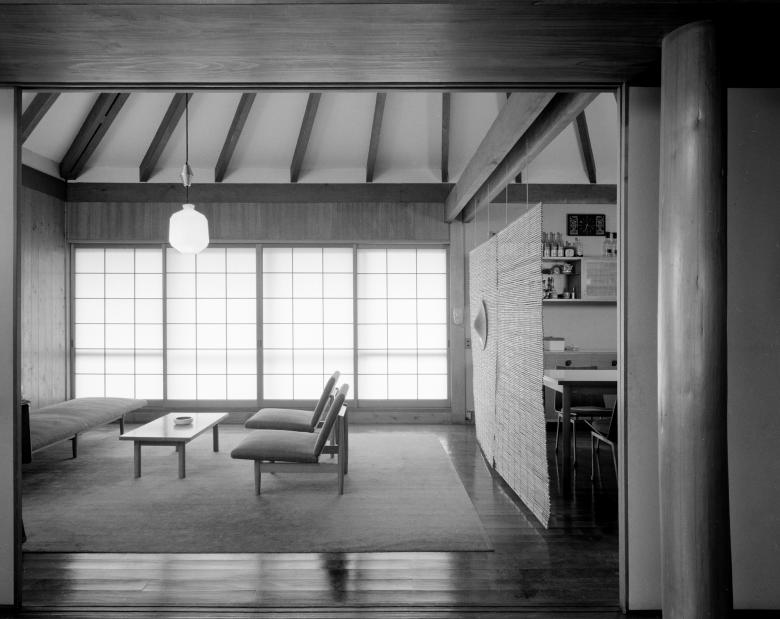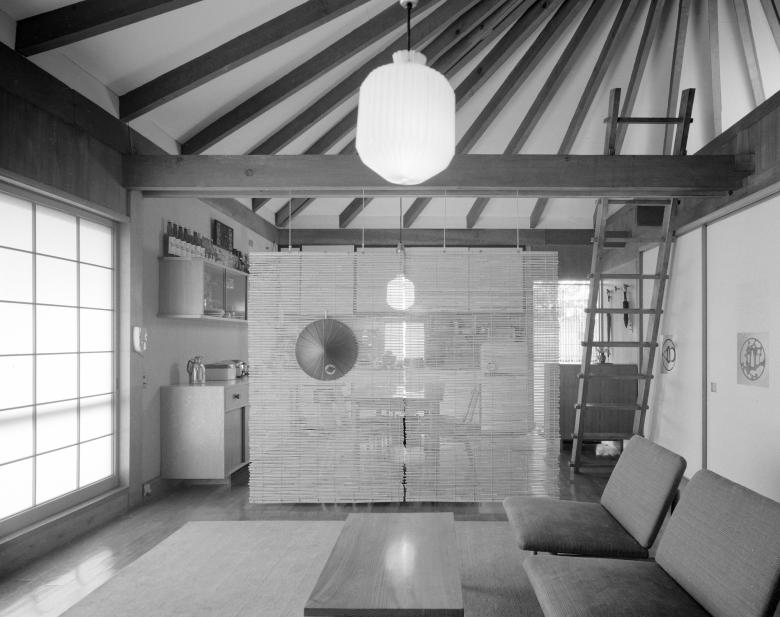Saving ‘Wasteful Space’
Ulf Meyer
10. Juni 2022
Umbrella House, Vitra Campus, June 2022. (Photo: Dejan Jovanovic © Vitra)
Architect Kazuo Shinohara’s Umbrella House has found a new home — in Germany, though, not in its former home of Japan. The building joins the Vitra Campus as a venue for small gatherings and, following buildings by R. Buckminster Fuller and Jean Prouvé, the third historic building to be transported there.
The Umbrella House that Kazuo Shinohara designed in 1961 is a milestone of postwar architecture in Japan, because of the way it reflects upon the history of the single-family house, that (still) main component of the Japanese metropolis. The timber frame home made of cedar, pine and Douglas fir offered space for a family. In his design, Shinohara used motifs of vernacular residential architecture, particularly the pyramidal roof found in Buddhist temples. Simple and inexpensive materials were used for the Umbrella House, including cement fiber panels for the facades.
The Umbrella House stimulated architectural discourse in Japan in the 1960s like no other house, because it was seen as a built critique of western functionalism and acted as the starting point of Shinohara’s great career as Japan’s most influential architect and theoretician of his generation. Shinohara graduated from Tokyo University of Science in 1947 with a bachelor's degree in mathematics. After visiting the Horiuji temples of Nara, he decided to major in architecture at the Tokyo Institute of Technology, earning a bachelor’s degree in architecture in 1953.
Umbrella House, Vitra Campus, June 2022. (Photo: Dejan Jovanovic © Vitra)
When recently the Umbrella House was supposed to be knocked down to make room for a highway, Kazuyo Sejima of SANAA contacted Rolf Fehlbaum, the owner of the Vitra furniture company in Germany, both known for strong architectural interest and patronage. Fehlbaum made it possible to disassemble the house in Tokyo’s Nerima ward and reassemble it on the grounds of the Vitra Campus in Weil am Rhein. In the process, he saved a landmark of modern design. With no functioning preservation of important buildings around in Japan, the country is continually losing some of its best patrimony in terms of modern architecture — the Nakagin Capsule Tower, obviously, but many more.
Shinohara (1925–2006) in his treaty, “A house is a work of art,” wrote a critique of both Western rationalism and Japanese Metabolism. His Umbrella House, with its disciplined geometry and abstraction in dialogue with Japanese Minka houses, has all the hallmarks of the first of his four styles. Measuring seven by seven meters in plan, the house asserts “waste space” through simplification to achieve “insufficient space,” as Shinohara called it. A main pillar, slightly offset from the center, anchors the floor plan and the five main components of the house: hiroma (living room), eat-in kitchen, bath, bedroom, and a tatami room with 15 half-size mats. The higher, flat-ceiling tatami room can be separated from the living room by five fusuma with prints by artist Setsu Asakura on the sliding doors. The four “rooms” are arranged around the tatami room in a pinwheel pattern. The ceiling beams and main mullions allude to oil-paper umbrellas (kara-kasa).
Umbrella House, Vitra Campus, June 2022. (Photo: Dejan Jovanovic © Vitra)
“This house is the smallest I ever designed. While I was working on it, I was also designing the House in Chigasaki, one of the largest houses I have ever built. At Chigasaki, I had begun to elaborate the idea of ‘wasteful space.’ In a small house, it would have been paradoxical to develop ‘wasteful space’ as a theme. ‘Wasteful space’ might be signified in a small house by emphasizing inherent emptiness as an ‘insufficient space.’ The expression of ‘wasteful space,’ even in a small house, could be achieved through a radical simplification of its functions.”
Umbrella House, Tokyo, ca. 1963-1964 (Photo © Akio Kawasumi)
Shinohara’s house combined “rigor with traditional Japanese forms to create a purist, poetic structure of modest scale but vast ambition,” according to scholar Seng Kuan in his 2019 book titled Traversing the House and the City. The architect combined “philosophical influences with artistic will and the owner’s preconceived ideas,” Kuan wrote. The square roof does not have a pillar to support it. The pillar only supports the intersection of beams passing through the space in a cross form. In that sense the name Umbrella House is misleading, because structurally it does not borrow from umbrellas. The visible structure of the roof spans a four-meter-tall room volume. The half-height space above the tatami room, which served as storage space, is accessed via a ladder.
"To oversee this house, I had to commute to the site in the suburbs of Tokyo. In winter the road to the site seemed very long. I wondered about the logic of designing, supervising and completing such a small house in the midst of our vast industrialized society. The real task of design is not the mere production of housing as a social goal, but the creation of spaces that appeal to people. Unless it attains the status of a work of art, a house has no reason for being. I wished to express the space in the doma (earthen-floor room) of a Japanese farmhouse, by means of the geometric structural design of a kara-kasa.”
Umbrella House, Tokyo, ca. 1963-1964 (Photo © Akio Kawasumi)
The Umbrella House was one of the last remaining examples of Shinohara’s “First Style” residences in Japan. The furniture was designed by Shinohara together with Katsuhiko Shiraishi; it consists partly of replicas and partly of originals. With the beauty, elegance and intellectual and artistic content saved from the ephemeral and merciless urban development of Tokyo, the Umbrella House has found an unexpected refuge in Germany. Rolf Fehlbaum is to be congratulated on this latest “catch,” while Japan should be licking its wounds.
